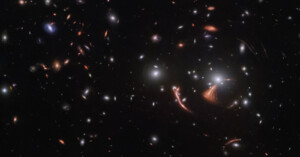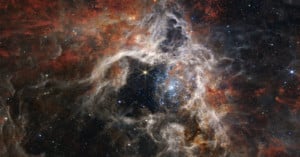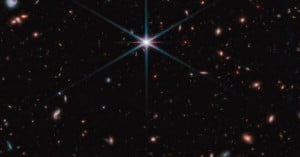
Stunning 3D Visualization Shows Pillars of Creation Like Never Before
NASA released an incredible new look at the Pillars of Creation, showing the celestial phenomenon in an entirely new way.

NASA released an incredible new look at the Pillars of Creation, showing the celestial phenomenon in an entirely new way.

Even as telescopes and observatories uncover more details about space, it remains mysterious. One puzzle revolves around the "smallest object that can form in a star-like manner," according to NASA. With the help of the James Webb Space Telescope, scientists have identified a new record holder for that category: a free-floating brown dwarf.

The James Webb Space Telescope (JWST) was 30 years in the making and now as it orbits the Sun delivering incredible imagery of the Universe a photographer who documented its construction has revealed his jaw-dropping pictures.

A new James Webb Space Telescope (JWST) image of the Ring Nebula that boasts an exquisite green looks like a sports stadium lit up at night at first glance.

The James Webb Space Telescope (JWST) has captured its first, raw images of Saturn that show the planet's famous rings in stunning, new detail.

NASA's James Webb Space Telescope has helped scientists achieve another breakthrough. Solar system scientists working to understand the origins of Earth's abundant water have used Webb's Near-Infrared Spectrograph (NIRSpec) instrument to confirm water vapor around a comet in the main asteroid belt for the first time.

NASA's James Webb Space Telescope has captured a stunning "smash-up" of two spiral galaxies. Collectively called Arp 220, the collision of the pair of galaxies has facilitated massive star formation.

Since NASA shared the first five images from the James Webb Space Telescope last July, astronomers have been busy using the telescope to study the cosmos and uncover new information about the origins of the universe. Scott Pelley took a closer look at Webb and its images in the most recent episode of "60 Minutes."

The James Webb Space Telescope has captured a gorgeous photo of the seventh planet from the Sun, Uranus. Not only that, but the rings around the ice giant are clearly visible for only the third time.

One of the first images the James Webb Space Telescope ever captured was only possible thanks to a gravitational lens. Its latest is another example of this phenomenon, this time featuring a galaxy called the Cosmic Seahorse.

The James Webb Space Telescope has captured what is known as a Wolf-Rayet star, the brief phase that comes just before it goes supernova. Due to how short the time is that a star is in this phase, it is one of the rarest astronomical observations.

The James Webb Space Telescope (JWST) has been used to identify six galaxies that potentially emerged extremely early in the universe’s history and are so massive they should not be possible under the current cosmological theory.

Following the success of the "Ultimate Space Telescope" documentary, PBS's science series NOVA has released a second film titled "New Eye on the Universe" that aims to provide a better understanding of how James Webb is deepening the understanding of the universe.

The James Webb Space Telescope has been used to identify a wide range of frozen gasses in a molecular cloud -- namely carbon, hydrogen, oxygen, nitrogen, and sulfur molecules -- which are the building blocks of habitable worlds.

Scientists have been given an unprecedented glimpse into the early stages of the universe thanks to new images from the James Webb Space Telescope (JWST).

Scientists have fused captures of the Pillars of Creation taken by the near-infrared and mid-infrared instruments on board the James Webb Space Telescope to show the star-forming region of space like never before.

The James Webb Space Telescope has captured a protostar that was previously hidden from other space telescopes in a dark cloud known as L1527. The photo reveals what appears as a "fiery hourglass" and gives astronomers insight into a new star's formation.

A mechanical issue that took the James Webb Space Telescope's Mid-Infrared Instrument (MIRI) offline on August 24 has been resolved and the camera has resumed full operation.

It's not just Hubble that's getting into the Halloween spirit. The James Webb Space Telescope team has released a new mid-infrared photo of the Pillars of Creation, a view that "strikes a chilling tone."

The James Webb Space Telescope (JWST or Webb) has captured a massive and stunningly detailed photo of the Pillars of Creation, a celestial region that gives birth to new stars.

A fascinating new image captured by the James Webb Space Telescope (JWST) captures 17 dust rings that resemble a fingerprint created by a rare type of star.

X-ray data from NASA's Chandra Observatory has been combined with the infrared data captured by the James Webb Space Telescope to create new composites that make the most of each's data gathering capabilities.

The James Webb Space Telescope and the Hubble Space Telescope both managed to capture detailed images of the impact of the planetary defense Double Asteroid Redirection Test (DART). It is the first time that Webb and Hubble have simultaneously observed the same celestial target.

NASA's James Webb Space Telescope has captured a photo of Neptune that displays the clearest view of the planet's rings in more than 30 years.

NASA has paused the use of one of the modes on the James Webb Space Telescope's (JWST) Mid-Infrared Instrument (MIRI) due to what it describes as "increased friction" that occurs during its setup phase ahead of new observations.

The James Webb Space Telescope (JWST) has captured a stunning mosaic image of the Tarantula Nebula that stretches 240 light-years across and includes tens of thousands of never-before-seen young stars that were not visible with previous telescopes.

One of the first five photos to be taken by the James Webb Space Telescope is being used by malicious actors to spread malware, as identified by securities analytics platform Securonix.

The James Webb Space Telescope (JWST) has captured its first direct image of a planet outside the Solar System. This exoplanet is a gas giant that has six to 12 times the mass of Jupiter and is relatively young: between 15 and 20 million years old.

The James Webb Space Telescope (JWST) team has translated some of the telescope's first photos into music. Called sonification, the goal is to make the JWST's image and data understandable through sound to help listeners create their own mental images.

A team of scientists has leveraged the James Webb Space Telescope (JWST) to produce a massive mosaic of space made up of 690 photos. The image covers an area of the sky about eight times as large as the telescope's first deep field image released on July 12.